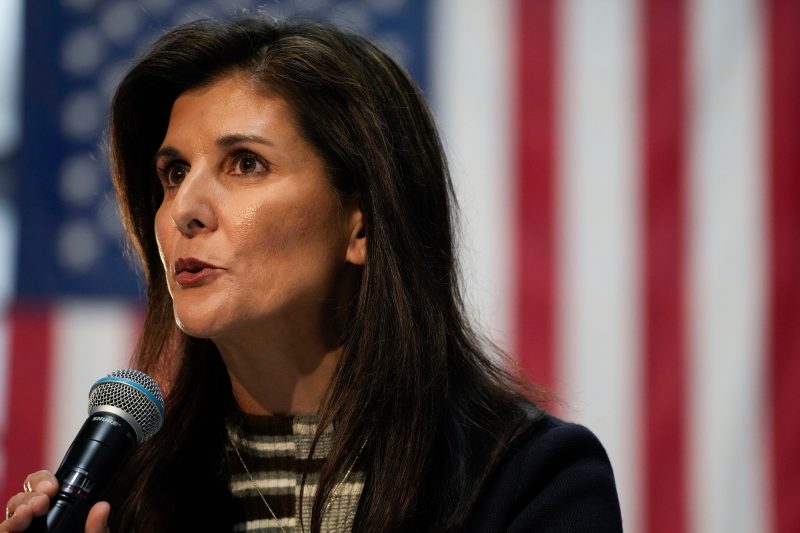“The number one thing I would do is stop giving foreign aid to our enemies.”
— Former U.N. ambassador Nikki Haley, in remarks on Fox News’s “Sunday Morning Futures,” Feb. 26
Haley, who recently launched her campaign for the Republican presidential nomination, is a former governor of South Carolina who also spent two years representing the United States at the United Nations during the Trump administration. Bashing foreign aid might be good politics, but one would think someone with her level of experience might have more than a passing familiarity with the basics.
Instead, she suggests that foreign aid goes directly to governments, especially ones with policies that are at odds with the interests of the United States. That’s wrong. The dirty little secret of foreign aid is that most of it never leaves the United States — and it goes right into the pockets of U.S. companies. Some countries receive direct grants of aid, but those are certainly not “enemies.”
In her conversation with Maria Bartiromo of Fox News, Haley ticked off some foreign aid numbers by way of example. She got many of the numbers wrong, and her list of enemies is a bit eclectic, though inclusion on the list is obviously a matter of opinion. We will go through her comments line by line, but first, some foreign policy basics.
According to surveys, many Americans have a misguided view of how much money the United States devotes to foreign aid. Polls consistently reveal that Americans believe that it is about 25 percent of the federal budget — and that a majority believe it should be more like 10 percent. In reality, foreign aid is less than 1 percent of the budget.
On top of that, other countries are more generous with foreign aid. By raw dollars, the United States gives more foreign aid than any other country. But when measured as a percentage of a country’s economy, the United States is far behind nations such as Britain, Norway, Sweden, Germany and the Netherlands. The United Nations has set a target of contributing 0.7 percent of gross national income in development aid; the United States clocks in with less than 0.2 percent, near the bottom of the list of major democracies, according to a 2020 report by the Organization for Economic Cooperation and Development.
Now we should explore who benefits from foreign aid. Much of the time, this aid does not actually leave U.S. shores. Then, if it does, it generally goes to nongovernmental organizations, not host governments. The exception might be direct cash transfers as a reward for counterterrorism operations to countries that support the United States, such as Turkey and Jordan, or Egypt and Israel for signing the Camp David Accords, according to the Congressional Research Service (CRS). Very little since the 1970s has been spent on direct construction of roads, irrigation systems, electric power facilities or similar projects, CRS said.
About two-thirds of U.S. foreign assistance funds in fiscal year 2018 were obligated to U.S.-based entities, CRS said. For instance, food aid must be purchased in the United States and by law must be shipped on U.S. carriers. With the exception of some aid given to Israel, all military aid must be used to purchase U.S. military equipment and training — meaning foreign military aid in reality is a jobs program in the United States.
With that context in mind, let’s go line by line through Haley’s comments.
“We give $46 billion in aid, in foreign aid.”
Haley gets this number correct. That is the figure for fiscal year 2022, according to the U.S. foreign assistance website. We will the assess the rest of her comments using the fiscal 2022 data.
“So, you’re basically talking about a billion dollars going to Iraq, who’s basically dealing with the Iranians, who are saying ‘Death to America.’”
Actually, the number is $200 million in 2022. About $80 million is for humanitarian assistance, while the rest mainly goes for civilian peace-building programs and a project to foster small and micro businesses. Haley’s staff noted that Iraq has received more than $1 billion over the last few years. The staff said she included the country — which the U.S. invaded 20 years ago and where U.S. troops still provide advice — as an enemy because Iran’s militias have deep ties to security forces receiving U.S. support.
“You’re giving $2 billion to Pakistan, who are harboring terrorists trying to kill our soldiers.”
The figure is $150 million in 2022. One-third is for humanitarian assistance. Haley’s staff noted that the Biden administration last year approved a $450 million project to sustain Pakistan’s F-16 fleet.
“You’re giving half a billion dollars to Zimbabwe, the most anti-American African country there is.”
The figure is about $310 million, about half for health (HIV/AIDS prevention) and $110 million for humanitarian assistance, such as through the World Food Program. Haley’s staff said that hundreds of millions of dollars is a significant obligation to U.S. taxpayers.
“You look at China. We’re giving China money for the environment. Are you kidding? We shouldn’t be giving them a single penny.”
Her comment refers to about $270,000 spent on programs aimed at ending illegal trade in endangered species and reducing illegal consumption of endangered turtles. The money supports civil society organizations.
“Belarus, who’s holding hands with Russia in this war against Ukraine.”
Virtually all of the $33 million listed for Belarus goes to civil society groups hoping to lead the dictatorship into democracy. A spokesperson for the U.S. Agency for International Development said no money was given to the Belarusian government in 2022.
During a visit to the United States in June, Svyatlana Tsikhanouskaya, the opposition leader who ran for president in a fraud-ridden election, thanked the agency “for the many years of assistance to deliver civil society. You were always on the side of the Belarusian people, and many organizations and people received your assistance, like an independent vocal journalist, entrepreneurs, civic activists, human rights defenders, and so on.” Haley’s staff said there was no justification for this aid, given Belarus’s record of voting against U.S. interests at the United Nations.
“And then you have got communist Cuba. We’re giving them money. And we have designated them a state sponsor of terrorism.”
The figure for 2022 is about $7 million, but again, it does not go to the communist government but to human rights and civil society groups. In calendar year 2022, the United States also provided $2 million in emergency relief after Hurricane Ian devastated the island and Cuba requested help. Haley’s staff noted that a Miami Herald report in October said that after a fire at an oil storage facility killed 16 people, USAID was unable to certify whether firefighters’ uniforms actually were sent to or arrived at their final destination.
“USAID provided 100 sets of fire-resistant coats, pants, gloves, boots, and helmets for Cuban firefighters,” a USAID spokesperson said. “U.S. Government officials transferred 43 [personal protective equipment] kits to the Cuban fire brigade on Sept. 13, 2022, and on Jan. 13, 2023, delivered the remaining 57 sets of firefighter PPE to the Cuban national firefighter’s school.” The cost was $364,511.
Haley’s response
“The United States sends billions of dollars to countries and entities that undermine and oppose American interests. That’s a fact,” said Haley spokesman Ken Farnaso in a statement. “Americans deserve to know where their tax dollars are going, and they deserve a foreign policy grounded in American strength and pride. President Haley will end foreign aid to our enemies and those who repeatedly seek to harm Americans.”
Not only did Haley exaggerate many figures, but she suggests that money intended for civil society and health groups somehow went to the governments themselves. That’s a misleading narrative. In any case, a substantial chunk of foreign aid dollars creates jobs in the United States.
As a former U.N. ambassador, Haley should know better. She earns Three Pinocchios.
(About our rating scale)
Send us facts to check by filling out this form
Sign up for The Fact Checker weekly newsletter
The Fact Checker is a verified signatory to the International Fact-Checking Network code of principles








